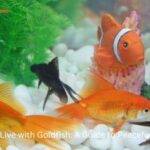Aquariums and Fish Tanks
What Fish Can Live in a 10-Gallon Tank: A Comprehensive Guide
What Fish Can Live in a 10-Gallon Tank? Setting up a 10-gallon aquarium opens up a world of possibilities for fishkeeping enthusiasts. While smaller than larger tanks, a well-maintained 10-gallon aquarium can provide a suitable home for a variety of fish species. In this guide, Guide to Fish Raising will explore the considerations for stocking a 10-gallon tank, suitable fish species, and tips for maintaining a healthy aquatic environment.
Considerations for Stocking a 10-Gallon Tank
Before selecting fish for your 10-gallon tank, it’s essential to understand the principles of stocking density, compatibility, and the specific needs of the fish species you plan to keep:
Tank Size
A 10-gallon tank provides limited space compared to larger aquariums. Therefore, fish selection should prioritize species that thrive in smaller environments and are compatible with each other.
Water Parameters
Different fish species have specific requirements for water temperature, pH levels, hardness, and cleanliness. Ensure that the species you choose have similar water parameter preferences to maintain a stable and healthy environment.
Compatibility
Some fish species are territorial or aggressive, while others are more peaceful. Choose fish that are compatible in terms of temperament and behavior to reduce stress and aggression in the tank.
Biological Load
The size and number of fish directly impact the biological load (waste production) in the tank. Avoid overcrowding to maintain good water quality and reduce the risk of stress-related diseases.
Aquascaping
Consider the layout and decoration of your tank to provide hiding places, territories, and swimming areas suitable for the fish species you intend to keep.
What Fish Can Live in a 10-Gallon Tank? Best Fish for a 10-Gallon Tank
Here are some of the best fish species that can live comfortably in a 10-gallon tank:
Betta Fish (Betta splendens)
Betta fish are a popular choice for small aquariums due to their stunning colors and unique personalities. Males are known for their long, flowing fins and vibrant hues, while females are less colorful but equally charming. Betta fish are relatively easy to care for and can thrive in a 10-gallon tank.
- Tank Requirements: Bettas prefer warm water with a temperature between 76-82°F (24-28°C). They also need a well-filtered tank and regular water changes to maintain water quality.
- Compatibility: Betta fish can be territorial, especially males. It’s best to keep only one male betta per tank. Females can be kept together in a group called a sorority, but they still require careful monitoring.
Neon Tetra (Paracheirodon innesi)

Neon tetras are small, colorful fish that are perfect for a 10-gallon tank. They are known for their iridescent blue and red stripes, making them a visually appealing addition to any aquarium. Neon tetras are peaceful and social fish that do well in groups.
- Tank Requirements: Neon tetras prefer a temperature range of 70-81°F (21-27°C) and slightly acidic to neutral pH levels. A well-planted tank with hiding spots will make them feel secure.
- Compatibility: Neon tetras are community fish and can be kept with other peaceful species. A group of 6-10 neon tetras will thrive in a 10-gallon tank.
Guppies (Poecilia reticulata)
Guppies are small, colorful, and active fish that are ideal for a 10-gallon tank. They come in a wide variety of colors and patterns, making them a popular choice for both beginner and experienced aquarists. Guppies are hardy fish and relatively easy to care for.
- Tank Requirements: Guppies prefer a temperature range of 72-82°F (22-28°C) and slightly alkaline water. A well-filtered tank with live plants will keep them healthy.
- Compatibility: Guppies are peaceful fish that can be kept with other non-aggressive species. A group of 6-8 guppies will do well in a 10-gallon tank.
Endler’s Livebearer (Poecilia wingei)
Endler’s livebearers are closely related to guppies and share similar care requirements. They are small, colorful fish that are known for their vibrant patterns and active behavior. Endler’s livebearers are easy to care for and breed readily in captivity.
- Tank Requirements: Endler’s livebearers prefer a temperature range of 72-82°F (22-28°C) and slightly alkaline water. A well-filtered tank with live plants is ideal.
- Compatibility: Endler’s livebearers are peaceful fish that can be kept with other non-aggressive species. A group of 6-8 Endler’s livebearers will thrive in a 10-gallon tank.
Harlequin Rasbora (Trigonostigma heteromorpha)
Harlequin rasboras are small, peaceful fish that are perfect for a 10-gallon tank. They are known for their striking black and orange coloration and their schooling behavior. Harlequin rasboras are hardy and relatively easy to care for.
- Tank Requirements: Harlequin rasboras prefer a temperature range of 72-81°F (22-27°C) and slightly acidic to neutral pH levels. A well-planted tank with plenty of swimming space is ideal.
- Compatibility: Harlequin rasboras are community fish and can be kept with other peaceful species. A group of 6-8 harlequin rasboras will do well in a 10-gallon tank.
Corydoras Catfish (Corydoras spp.)
Corydoras catfish are small, bottom-dwelling fish that are perfect for a 10-gallon tank. They are known for their peaceful nature and their ability to help keep the tank clean by scavenging for leftover food. Corydoras catfish are social fish that do best in groups.
- Tank Requirements: Corydoras catfish prefer a temperature range of 72-78°F (22-26°C) and slightly acidic to neutral pH levels. A soft substrate and plenty of hiding spots will make them feel comfortable.
- Compatibility: Corydoras catfish are peaceful and can be kept with other non-aggressive species. A group of 4-6 Corydoras catfish will thrive in a 10-gallon tank.
Cherry Shrimp (Neocaridina davidi)
While not a fish, cherry shrimp are a great addition to a 10-gallon tank. They are small, colorful shrimp that are known for their bright red coloration and active behavior. Cherry shrimp are easy to care for and can help keep the tank clean by eating algae and detritus.
- Tank Requirements: Cherry shrimp prefer a temperature range of 68-78°F (20-26°C) and slightly acidic to neutral pH levels. A well-planted tank with plenty of hiding spots is ideal.
- Compatibility: Cherry shrimp are peaceful and can be kept with other non-aggressive fish. A group of 10-20 cherry shrimp will do well in a 10-gallon tank.
Setting Up a 10-Gallon Tank
Creating a healthy and visually appealing environment for your fish requires careful planning and attention to detail. Here are some essential steps for setting up a 10-gallon tank:
Choosing the Right Equipment
- Aquarium: A standard 10-gallon tank is suitable for the fish species mentioned above. Ensure the tank is placed on a sturdy stand or surface.
- Filter: A good quality filter is essential for maintaining water quality. A sponge filter or a hang-on-back filter with adjustable flow is ideal for a 10-gallon tank.
- Heater: A reliable heater is necessary to maintain a stable water temperature. Choose a heater with a built-in thermostat to ensure accurate temperature control.
- Lighting: Proper lighting is important for both the fish and any live plants in the tank. LED lights are energy-efficient and provide good illumination.
- Substrate: Choose a suitable substrate based on the needs of your fish and plants. Gravel, sand, and plant-specific substrates are popular options.
Setting Up the Tank
- Clean the Tank: Rinse the tank, substrate, and any decorations with water to remove dust and debris. Avoid using soap or chemicals.
- Add Substrate: Spread a layer of substrate on the bottom of the tank. The depth should be around 1-2 inches, depending on the type of substrate and plants.
- Install Equipment: Place the filter, heater, and any other equipment in the tank according to the manufacturer’s instructions.





